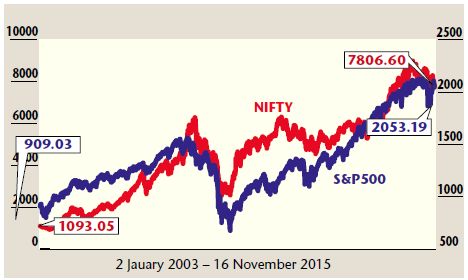
… with NIFTY 50 and S&P 500 showing positive correlation, will drive Indian equities higher.
As the US Fed meet nears, investors start fretting over the possibility of an interest rate hike. The interest rates in the US have remained low for an extended period of time. The Federal Reserve has not raised rates for almost a decade to support its ailing economy, which was hit by the sub-prime crisis. After many years of tepid growth, the data points coming from the US are showing signs of a revival.
The US economy seems to be on the mend. It has added 271,000 new jobs in October at the fastest pace of the year, beating the consensus estimates of 185,000 jobs. The unemployment rate has fallen to a seven-year low. Wages are on a rise. The housing stats for September increased by 6.5 per cent, the second highest level seen in eight years. This has increased the probability of an interest rate hike in the forthcoming meeting scheduled in mid-December. Janet Yellen, chairperson, the US Fed, had earlier hinted at the possibility of a rate hike in December, if data points continued to surprise positively.
The fortunes of many emerging economies are linked to the growth in developed economies. The revival of the US economy will create a ripple effect globally, with the India also benefiting from this improvement. Even though India is not completely dependent on the US economy, the significant portion of its exports are to the US. The improvement in the US economy will provide a boost to export-driven industries such as IT, pharma, gems & jewellery, textiles, etc.
The government of India is committed to walking the credible path to fiscal consolidation. It is facing the tough task of reviving its economy through increased infrastructure spending, even as growth in tax revenue continues to remain sluggish. India’s trade deficit continues to shrink, despite the fall in merchandise exports. India’s exports have shrunk due to the extended slowdown in developed economies. India’s import bill has come down primarily due to the fall in the prices of crude oil and lower non-oil imports. The revival of the US economy should boost India’s exports.
Stock markets are a barometer of economic growth. As the US economy recovery gathers steam, the US stock markets would follow the trend. The dollar is showing tremendous strength against major global currencies..
Over the years, India has witnessed a significant flow of foreign investments into the country – be it hot money in the form of foreign portfolio investments (FPIs) or long-term investment in direct economy through FDI. The increase in foreign participation into Indian equities over the years has resulted in a high degree of positive correlation with the US markets. India’s NIFTY 50 shows high positive correlation with the US’ S&P 500.
The macro-fundamentals of India have shown considerable improvement after the new government has taken control. Inflation is under check despite a weak monsoon. The results announced by Indian companies reflect a lack of demand revival affecting topline growth, but operating margins have improved due to a fall in raw material prices. The demand revival should help improve corporate earnings in the coming quarters. India is one of the most sought-after emerging markets for foreign investors. Private equity major Blackstone, has announced its intention to invest over $2-3 billion in India over the next 5-6 years.
The government of India has announced various reforms and has laid the red carpet for foreign investors. It has eased the FDI approval process and has also relaxed foreign investment rules in 15 key sectors, as a measure to boost investor confidence. This shows its commitment to push through reforms in an effort to revive the economy.
The global markets are showing nervousness in anticipation of a long-awaited US rate hike. The beginning of the tightening cycle could result in knee-jerk reaction in the global financial markets, driving foreign funds back to the US. While this event can create panic in the immediate term, its impact on India is likely to be limited in the medium term. The ongoing revival of the US economy and the higher correlation between Indian equities and US equities will drive Indian equities higher. Indian stock markets will benefit through higher allocation of foreign funds into India. India certainly is a bright spot in an otherwise gloomy global economy.
This article was originally published in Business India Magazine.
Write to us at news@valuelineadvisors.com
Disclaimer: The views expressed in this article are personal and the author is not responsible in any manner for the use which might be made of the above information. None of the contents make any recommendation to buy, sell or hold any security and should not be construed as offering investment advice.
